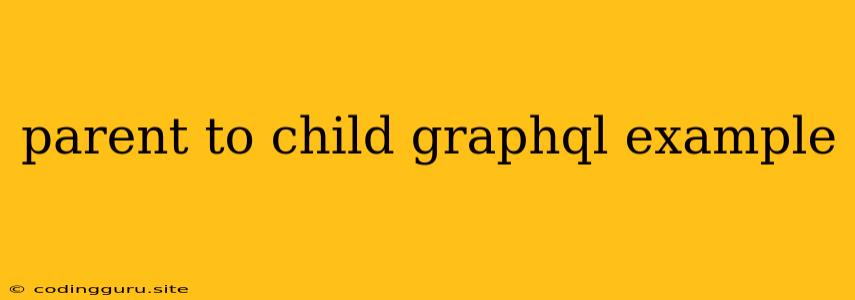Exploring Parent-to-Child Relationships in GraphQL
GraphQL is a powerful query language for APIs that excels at fetching data from different sources efficiently. One of its key strengths lies in its ability to represent data relationships effectively, particularly the parent-to-child relationship. This article will delve into the world of parent-to-child relationships within GraphQL, demonstrating how to model and query such connections for a seamless data retrieval experience.
What are Parent-to-Child Relationships in GraphQL?
At its core, GraphQL represents data as a graph structure. This structure allows for the definition of nodes (individual entities) and their relationships to each other. A parent-to-child relationship implies that one node (the parent) holds a collection of other nodes (the children) that are directly linked to it.
For instance, consider a simple scenario involving authors and their books:
- Parent: Author
- Children: Books
Here, an author (the parent) might have multiple books (the children) associated with them. GraphQL facilitates the retrieval of both author and book information within a single query, seamlessly traversing this parent-to-child relationship.
Modeling Parent-to-Child Relationships in Your Schema
The foundation for effective parent-to-child data retrieval lies in properly defining your GraphQL schema. This schema acts as the blueprint for your data structure. Let's illustrate this with a schema example:
type Author {
id: ID!
name: String!
books: [Book]
}
type Book {
id: ID!
title: String!
author: Author
}
type Query {
author(id: ID!): Author
books: [Book]
}
In this schema:
- Author is a type representing an author node.
- Book is a type representing a book node.
- books: [Book] within the Author type denotes a field that represents the children (books) belonging to a specific author.
- author: Author within the Book type indicates a field referencing the parent author for each book.
Querying Parent-to-Child Relationships
Once your schema is defined, you can query your data using GraphQL. Let's look at some examples of how to fetch parent-to-child data:
1. Fetching an Author and Their Associated Books:
query {
author(id: "1") {
id
name
books {
id
title
}
}
}
This query retrieves the author with an ID of "1" along with their associated books, including their IDs and titles. The nested structure within the query (books { ... }) indicates the traversal of the parent-to-child relationship.
2. Fetching a Book and its Author:
query {
book(id: "2") {
id
title
author {
id
name
}
}
}
This query fetches a book with an ID of "2" and retrieves the author associated with that book, including their ID and name. Again, the nested structure (author { ... }) enables traversing the child-to-parent relationship.
Key Considerations for Parent-to-Child Relationships
- Data Integrity: Ensure that your schema reflects the true relationships in your data. Incorrectly defined relationships can lead to inconsistent data retrieval.
- Efficiency: GraphQL provides flexibility in querying specific data. Avoid fetching unnecessary data by carefully selecting fields in your queries.
- Relationships: Beyond the parent-to-child relationship, GraphQL allows for many-to-many relationships, which can be modelled using techniques like intermediate tables or lists.
Conclusion
Parent-to-child relationships are an essential aspect of modelling data in GraphQL. By carefully defining your schema and using appropriate queries, you can leverage GraphQL's power to retrieve related data efficiently and effectively. Mastering these concepts empowers you to build robust GraphQL APIs that handle complex data structures with ease.
